Pistol brick

|
| Two types of pistol brick. On the left, laid as a 'soldier' with a deep rebate and downstand that may be used to conceal a concrete toe; on the right, laid as a 'stretcher' which may be used to conceal a supporting steel angle. |
When brickwork is used as a cladding – whether to clad concrete- or steel-framed buildings, or low-rise cavity-wall construction, the bricks must be supported and tied back to the structure. This is often achieved with the use of steel angles, lintels, concrete toes or edge beams. Onto these are placed specially-made ‘pistol’ bricks (or rebated bricks) that conceal the method of support and the mortar bed.
This is due to the rebate cut it into the base and which creates a small downstand that conceals the support and the mortar joint. The result is a flush appearance.
A pistol brick gets its name from its pistol shape.
Pistol bricks can either be laid as stretchers (horizontally) or ‘brick-on-edge (vertically, as ‘soldiers’). The depth of rebate will depend on how the brick is arranged and the supporting construction. For example, when supported on a concrete toe that is 50mm deep, the rebate that will be cut into a soldier brick will be 50mm + 10mm (mortar joint) = 60mm deep. If a standard brick length is 215mm, this will leave a brick ‘body of 155mm. Between every third or fourth brick, there must usually be some form of metal tie restraint to tie the bricks back to the structure.
Because pistol bricks are special bricks and involve a change from normal brick dimensions, they involve first, special manufacture (and so higher costs) and second, a longer lead-in period until they can be delivered to the site. These factors must be weighed-up by the designer against the importance placed on the finished effect.
When considering whether to opt for pistols or any other type of brick, specifiers should consult with the brick manufacturer to ensure that what they propose can be feasibly manufactured in the timeframe required and for the available budget, and that it embodies no obvious in-use failure points.
[edit] Related articles on Designing Buildings Wiki
Featured articles and news
RTPI leader to become new CIOB Chief Executive Officer
Dr Victoria Hills MRTPI, FICE to take over after Caroline Gumble’s departure.
Social and affordable housing, a long term plan for delivery
The “Delivering a Decade of Renewal for Social and Affordable Housing” strategy sets out future path.
A change to adoptive architecture
Effects of global weather warming on architectural detailing, material choice and human interaction.
The proposed publicly owned and backed subsidiary of Homes England, to facilitate new homes.
How big is the problem and what can we do to mitigate the effects?
Overheating guidance and tools for building designers
A number of cool guides to help with the heat.
The UK's Modern Industrial Strategy: A 10 year plan
Previous consultation criticism, current key elements and general support with some persisting reservations.
Building Safety Regulator reforms
New roles, new staff and a new fast track service pave the way for a single construction regulator.
Architectural Technologist CPDs and Communications
CIAT CPD… and how you can do it!
Cooling centres and cool spaces
Managing extreme heat in cities by directing the public to places for heat stress relief and water sources.
Winter gardens: A brief history and warm variations
Extending the season with glass in different forms and terms.
Restoring Great Yarmouth's Winter Gardens
Transforming one of the least sustainable constructions imaginable.
Construction Skills Mission Board launch sector drive
Newly formed government and industry collaboration set strategy for recruiting an additional 100,000 construction workers a year.
New Architects Code comes into effect in September 2025
ARB Architects Code of Conduct and Practice available with ongoing consultation regarding guidance.
Welsh Skills Body (Medr) launches ambitious plan
The new skills body brings together funding and regulation of tertiary education and research for the devolved nation.
Paul Gandy FCIOB announced as next CIOB President
Former Tilbury Douglas CEO takes helm.
UK Infrastructure: A 10 Year Strategy. In brief with reactions
With the National Infrastructure and Service Transformation Authority (NISTA).






















